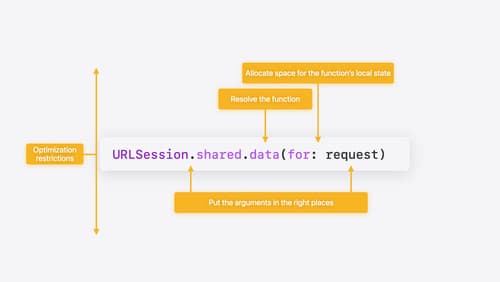GCD comparing with Swift Concurrency
Asked on 2024-10-03
1 search
When comparing Grand Central Dispatch (GCD) with Swift Concurrency, there are several key differences and improvements that Swift Concurrency offers:
-
Concurrency Model: GCD uses a queue-based model where you manually manage the execution of tasks on different queues. Swift Concurrency introduces a more structured concurrency model using async/await and actors, which simplifies the management of concurrent tasks and helps avoid common pitfalls like data races.
-
Actors: Swift Concurrency introduces actors, which are designed to protect mutable state and ensure data isolation. This is a significant improvement over GCD, where managing shared mutable state can be complex and error-prone.
-
Data Race Safety: Swift 6 provides data race safety by default, turning potential data race issues into compile-time errors. This is a major advantage over GCD, where data races can lead to unexpected runtime behavior and are often difficult to debug.
-
Main Actor: Swift Concurrency allows you to specify that certain tasks should run on the main actor, which is particularly useful for UI updates. This is more declarative compared to GCD, where you manually dispatch tasks to the main queue.
-
Async/Await: The async/await syntax in Swift Concurrency provides a more readable and maintainable way to write asynchronous code compared to the callback-based approach often used with GCD.
For more details on Swift Concurrency and its benefits over GCD, you can refer to the session Migrate your app to Swift 6 (00:00:58) which discusses the transition from a GCD-based concurrency model to Swift Concurrency.

Migrate your app to Swift 6
Experience Swift 6 migration in action as we update an existing sample app. Learn how to migrate incrementally, module by module, and how the compiler helps you identify code that’s at risk of data races. Discover different techniques for ensuring clear isolation boundaries and eliminating concurrent access to shared mutable state.

What’s new in Swift
Join us for an update on Swift. We’ll briefly go through a history of Swift over the past decade, and show you how the community has grown through workgroups, expanded the package ecosystem, and increased platform support. We’ll introduce you to a new language mode that achieves data-race safety by default, and a language subset that lets you run Swift on highly constrained systems. We’ll also explore some language updates including noncopyable types, typed throws, and improved C++ interoperability.

Explore Swift performance
Discover how Swift balances abstraction and performance. Learn what elements of performance to consider and how the Swift optimizer affects them. Explore the different features of Swift and how they’re implemented to further understand the tradeoffs available that can impact performance.
